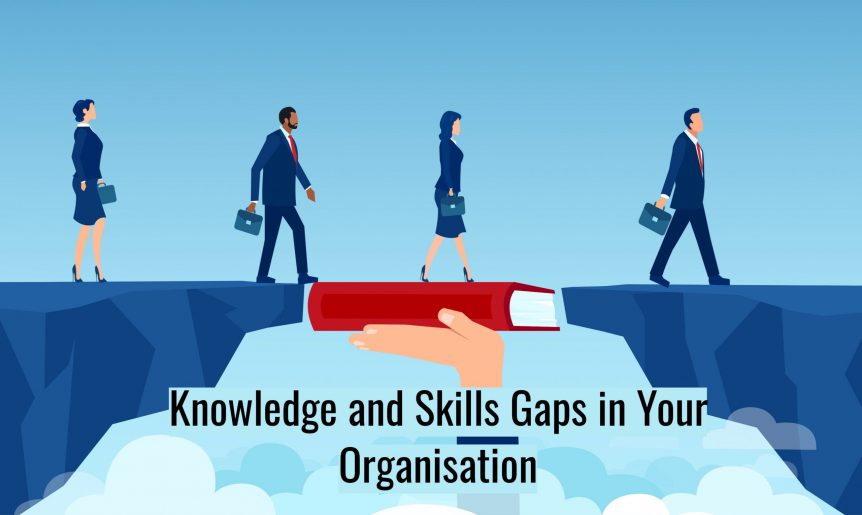You’ve Identified Knowledge and Skills Gaps in Your Organisation – Here’s What to Do Next
Identifying knowledge and skills gaps in your organisation simply describes a problem. This identification process is important, but you also need solutions. This is often referred to as bridging the skills gap.
This blog is the third in our series on knowledge and skills gaps. In the first blog, we outlined the importance of identifying knowledge and skills gaps as well as defining what the terms mean. In the second blog, we explored the steps you should take to find your company’s skills and knowledge gaps.
What happens next? How do you bridge the skills gaps you have identified as being important to your business?
Bridging Knowledge and Skills Gaps
There are several approaches you can take to bridge knowledge and skills gaps. In most situations, you will need to look at multiple areas and implement several different strategies to ensure your team has the knowledge and skills your business needs. Let’s look at the most important.
Communicate with Your Team
Opening a dialogue with your team and informing them of your objectives is a key part of the process. This is particularly important for the aspects they will be involved with, such as completing new training modules.
By communicating, you can reduce resistance to various measures. In fact, in many situations, you can create enthusiasm, particularly if people see they will benefit professionally from the new skills or knowledge training.
Develop New Training Modules
You are likely to need new training modules for some, if not all, of the skills and knowledge gaps you have identified.
You will need to decide on the best training delivery method for each subject area, as well as the best way of delivering and/or putting together the content.
E-learning is likely to play a big role, both custom-made e-learning modules and off-the-shelf courses for more common topics, such as soft skills.
You may also need in-person training, on-the-job training, and strategies like assigning mentors to employees to help them improve in the areas that your business needs.
Developing new e-learning content and other training modules will require investment. The upside is it will improve your business in areas you have identified as being important, delivering a return on investment.
In fact, when developing a training strategy, one of the most cost-effective approaches you can take is the skills and knowledge gap approach.
Review Your Recruitment Strategy
It is also important that you review your recruitment strategy and processes. The big question to answer is: are you hiring people with the right skills?
Maybe there is too much focus on qualifications rather than things like soft skills or real-life experience. Maybe your recruitment team doesn’t have the level of understanding required to ensure they know how to hire the right people. Maybe the work experience of candidates is not being assessed in a way that is beneficial to your business.
The solutions to the above could include revising your recruitment processes, updating job descriptions, and training your HR team.
Review Your HR Strategy
Staff retention might be another cause of knowledge and skills gaps in your business. In other words, you can hire the right people, but your business isn’t as good as it should be in keeping them.
Even worse, you are good at training your employees to a standard your business needs, but many then move to other companies, leaving you to start the process again.
Working on improving staff retention rates in your business will help solve these problems.
Adapt Your Recruitment Strategy
While training existing staff to give them the knowledge and skills that your business needs is the right solution in many situations, it is not always the best approach. In some circumstances, you will need to bring in new talent.
This might mean looking at different talent pools, such as people in different industries, or people outside Saudi Arabia or the UAE. The important part is to ensure the new people you hire help to bridge your knowledge and skills gaps.
Make the Most of Technology
Technology can form part of the solution as well, depending on the knowledge or skills gaps you are bridging. For example, if you want to improve project management capabilities in your business, a project management app might help, while a CRM tool might be effective in helping to bridge gaps related to customer service skills.
Create a Learning Culture
Finally, creating a learning culture in your organisation will raise overall standards and get your team in the mindset of continuous professional development. A learning culture takes time to develop, but it can be highly beneficial.
Rinse & Repeat
Identifying, assessing, and then bridging knowledge and skills gaps in your organisation is an ongoing process. The reasons for this are varied. People will leave your organisation, for example, taking essential knowledge and skills with them – knowledge and skills that can be difficult to replace.
Other examples include the pace of technological change, the evolving nature of customer expectations, and emerging competitive threats.
Therefore, it’s important you regularly repeat the process of looking at the skills and knowledge your business needs, assessing current capability levels, and then implementing solutions to bridge any gaps you identify. Doing so will help you remain competitive and profitable while continuing to deliver high-quality solutions to your customers.

